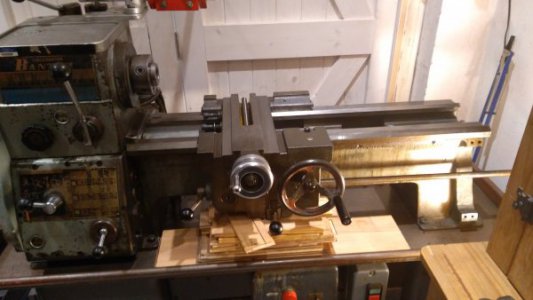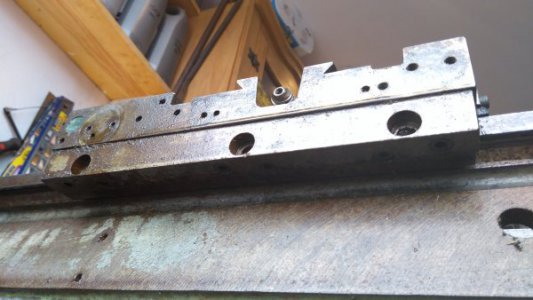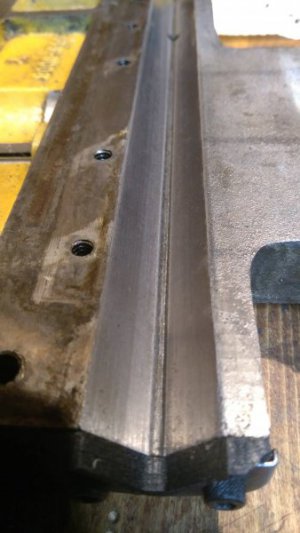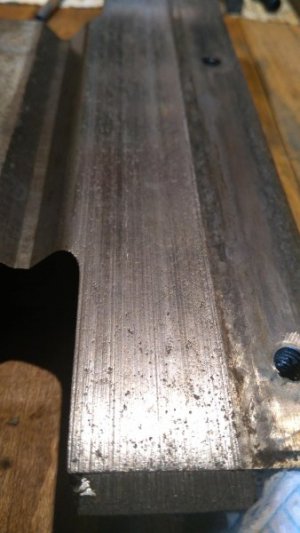Having moved my lathe around the workshop, I've spent a fair bit of time on levelling and aligning the lathe headstock and ways and think I'm pretty close on the money now (testing with 11" ground test bar mounted directly in the spindle taper). I am now seeing just under 3/10,000" run out at the spindle end of the bar (1/2" out from spindle nose) and this rises to just under 1/1000" at far end of the bar (11" from spindle nose).
The run out is periodic and symetric, and I have aligned the headstock so that it is zeroed on the mid point according to the dial indicator and this is also zero at the end of the bar. What I don't quite understand is that as I rack the carriage along the bed I see a large variation in the dial indicator reading as I move along the bed. The dial indicator is metric and shows micron divisions (1/1000 of a mm or approx 4/100,000") - I get around 30um variation as I track along the bar, which I believe is the carriage rising and falling taking the dial indicator off centre.
I was thinking this might be bed wear or some slack/adjustment required in the carriage gibbs, but after videoing it I'm not so sure as the dial indicator reading seems to be influenced 20-30um by the reversing the direction of racking. I wondered if perhaps I might be skewing the carriage slightly, I can definitely change the indicator readings by lifting the front of the carriage or pushing down at the rear.
I've shot two short videos to try and show this and think I have reduced the error a little in the second run by tightening up the 3 allen bolts at the rear of the carriage (which I assumed were a gib adjustment) - the manual isn't too helpful here, but it looks like there might be adjustment at the front of the carriage, but I think I need to remove the apron to get access here (parts diagram below):
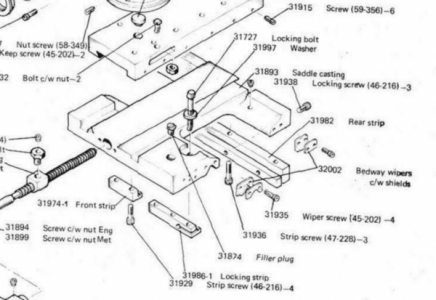
The run out error is not too excessive, but not sure I can be certain of my alignment as a longer test bar might give a different result - would appreciate any insight on probable cause and if I should strip the apron to adjust the carriage. It probably could use a proper clean after 50 odd years, but looks quite a messy job!
The run out is periodic and symetric, and I have aligned the headstock so that it is zeroed on the mid point according to the dial indicator and this is also zero at the end of the bar. What I don't quite understand is that as I rack the carriage along the bed I see a large variation in the dial indicator reading as I move along the bed. The dial indicator is metric and shows micron divisions (1/1000 of a mm or approx 4/100,000") - I get around 30um variation as I track along the bar, which I believe is the carriage rising and falling taking the dial indicator off centre.
I was thinking this might be bed wear or some slack/adjustment required in the carriage gibbs, but after videoing it I'm not so sure as the dial indicator reading seems to be influenced 20-30um by the reversing the direction of racking. I wondered if perhaps I might be skewing the carriage slightly, I can definitely change the indicator readings by lifting the front of the carriage or pushing down at the rear.
I've shot two short videos to try and show this and think I have reduced the error a little in the second run by tightening up the 3 allen bolts at the rear of the carriage (which I assumed were a gib adjustment) - the manual isn't too helpful here, but it looks like there might be adjustment at the front of the carriage, but I think I need to remove the apron to get access here (parts diagram below):

The run out error is not too excessive, but not sure I can be certain of my alignment as a longer test bar might give a different result - would appreciate any insight on probable cause and if I should strip the apron to adjust the carriage. It probably could use a proper clean after 50 odd years, but looks quite a messy job!


